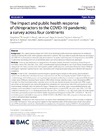The impact and public health response of chiropractors to the COVID-19 pandemic: a survey across four continents

Abstract
Background: The unprecedented impact of COVID-19 on healthcare professionals has implications for healthcare delivery, including the public health guidance provided to patients. This study aims to assess the response and impact of COVID-19 on chiropractors internationally, and examines the public health response of chiropractors to the COVID-19 pandemic practising under a musculoskeletal spine-care versus subluxation-based care paradigm.
Methods: A survey was distributed to chiropractors in Australia, Canada, Denmark, Hong Kong, United Kingdom and United States (Oct. 2nd–Dec. 22nd, 2020) via professional bodies/publications, and social media. Questions were categorised into three domains: socio-demographic, public health response and business/financial impact. Multivariable logistic regression explored survey items associated with chiropractors practising under different self-reported paradigms.
Results: A total of 2061 chiropractors representing four global regions completed the survey. Our recruitment method did not allow the calculation of an accurate response rate. The vast majority initiated COVID-19 infection control changes within their practice setting, including increased disinfecting of treatment equipment (95%), frequent contact areas (94%) and increased hand hygiene (94%). While findings varied by region, most chiropractors (85%) indicated that they had implemented regulator advice on the use of personal protective equipment (PPE). Suspension of face-to-face patient care during the peak of the pandemic was reported by 49% of the participants with 26% implementing telehealth since the pandemic began. Chiropractors practising under a musculoskeletal spine-care paradigm were more likely to implement some/all regulator advice on patient PPE use (odds ratio [OR] = 3.25; 95% confidence interval [CI]: 1.57, 6.74) and practitioner PPE use (OR = 2.59; 95% CI 1.32, 5.08); trust COVID-19 public health information provided by government/World Health Organisation/chiropractic bodies (OR = 2.47; 95% CI 1.49, 4.10), and initiate patient telehealth in response to COVID-19 (OR = 1.46; 95% CI 1.02, 2.08) compared to those practising under a subluxation-based paradigm.
Conclusions: Chiropractors who responded to our survey made substantial infectious control changes in response to COVID-19. However, there was regional variation in the implementation of the advised practitioner and patient use of PPE and limited overall use of telehealth consultations by chiropractors during COVID-19. Musculoskeletal spine-care chiropractors were more adaptive to certain COVID-19 public health changes within their practice setting than subluxation-based chiropractors.
Collections
Date
2022-05-09Author
Moore, Craig
Wong, Arnold Y. L.
de Luca, Katie
De Carvalho, Diana
Johansson, Melker S.
Pohlman, Katherine A.
Miller, Amy
Funabashi, Martha
Dougherty, Paul
French, Simon
Adams, Jon
Kawchuk, Greg